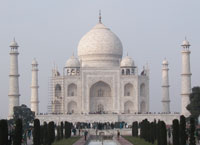 |
| Home Send Money to India Modes of money transfer India BPO India Tourism Taj Mahal Kumarakom Lakes Jaipur Pink city Alappuzha Backwaters Goa Tourism Munnar Hill Station India States Andhra Pradesh Assam Bihar Chattisgarh Goa Gujarat Haryana Himachal Pradesh Jammu and Kashmir Jharkhand Karnataka Kerala Madhya Pradesh Maharashtra Manipur Meghalaya Mizoram Nagaland Punjab Rajasthan Sikkim Tamil Nadu Orissa Tripura Uttar Pradesh Uttaranchal West Bengal India Quick Links Indiaweblinks World Wonders Web 123 Biotech Honeymoon Packages |
India States - Tripura  Tripura used to be a royal state before independence.The Tribal Kings had the title of Manikya and ruled Tripura for hundreds of years until its incorporation into India in 1949. The capital of the Kingdom was based in Udaipur which was known as Rangamati on the banks of the river Gomati in South Tripura. The capital was shifted first to Old Agartala and then the present Agartala in the 19th Century. As a revolt against the monarchic rule, the Ganamukti Parishad movement was launched. The movement was victorious and Tripura was integrated with India. It was heavily affected by partition and its population now consists of Bengalis living side by side with the native tribal population.
Tripura used to be a royal state before independence.The Tribal Kings had the title of Manikya and ruled Tripura for hundreds of years until its incorporation into India in 1949. The capital of the Kingdom was based in Udaipur which was known as Rangamati on the banks of the river Gomati in South Tripura. The capital was shifted first to Old Agartala and then the present Agartala in the 19th Century. As a revolt against the monarchic rule, the Ganamukti Parishad movement was launched. The movement was victorious and Tripura was integrated with India. It was heavily affected by partition and its population now consists of Bengalis living side by side with the native tribal population.
Tripura offers plenty of attractions for the tourists in the form of magnificent palaces ( Ujjayanta Palace and Kunjaban Palace at Agartala and Neermahal - Lake Palace at Melaghar ), splendid rock-cut carvings and stone images ( Unakoti near Kailashahar, Debtamura near Amarpur and Pilak in Belonia Sub-divisions ), important temples of Hindus and Buddhists including the famous Mata Tripureswari temple ( one of the 51 Pithasthans as per Hindu mythology ) at Udaipur, vast natural as well as artificial lakes namely Dumboor lake in Gandacherra subdivision, Rudrasagar at Melaghar, Amarsagar, Jagannath Dighi, Kalyan Sagar, etc. at Udaipur, the beautiful hill station of Jampui hill bordering Mizoram, wild life sanctuaries at Sepahijala, Gumti, Rowa and Trishna and rich cultural heritage of Tribals, Bengalis and Manipuri communities residing in the state.
Like the other states of India, Tripura has a democratic government. Officially, the Governor heads the executive. The Chief Minister leads the democratically elected state legislature - which currently has 60 members. Gauhati High court (Agartala bench) heads the state's judicial administration. For administrative purposes, the state has been divided into 4 districts, 15 subdivisions, 38 development blocks. It also has an autonomous council, the Tripura Tribal Areas Autonomous District Council. Tripura's gross state domestic product for 2004 is estimated at $2.1 billion in current prices. Agriculture is the mainstay of Tripura's economy. Agricultural sector provides employment to nearly 51 % of the total workers in the State. However, handicraft, particularly made of bamboo,also finds a special mention in the states' economy. The per capita income at current prices of the state stands at Rs 10931 and at constant prices Rs 6813 in the financial year 2000-2001. Temple in the Palace CompoundSome quality timber like Sal, Garjan, Teak, Gamar are found abundantly in the forests of the State. The most important mineral resource of Tripura is oil and natural gas. However, the industrial sector in this State continues to be highly underdeveloped.
 There is a common belief that the name of the State has originated from "Tripura Sundari" - the presiding deity of the land which is famous as one of the 51 pethos of Hindu Pilgrims. Apart from this traditional view it is believed that originally the land was known as "Tuipra" meaning a land adjoining the water. It is fact that in days of yore the boundaries of Tripura was extended up to the Bay of Bengal when its rulers held sway from Garo hills to Arakan. There is a common belief that the name of the State has originated from "Tripura Sundari" - the presiding deity of the land which is famous as one of the 51 pethos of Hindu Pilgrims. Apart from this traditional view it is believed that originally the land was known as "Tuipra" meaning a land adjoining the water. It is fact that in days of yore the boundaries of Tripura was extended up to the Bay of Bengal when its rulers held sway from Garo hills to Arakan.
|
|
|
|

